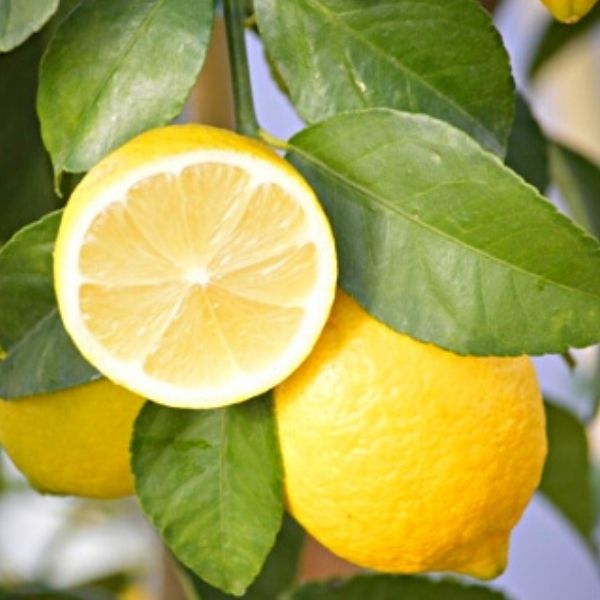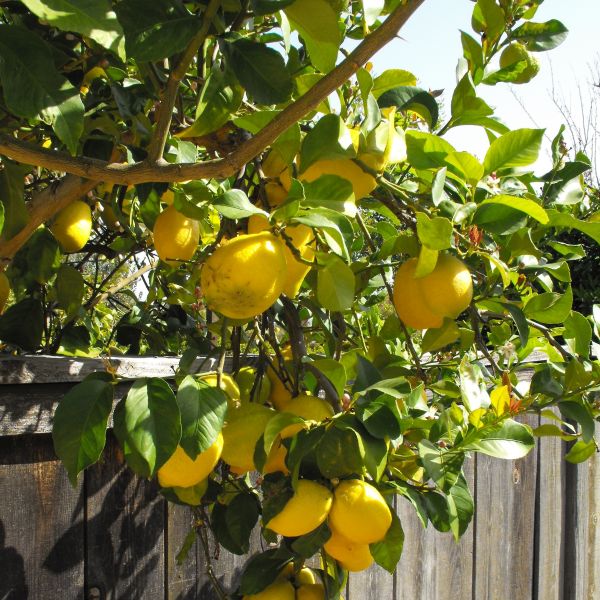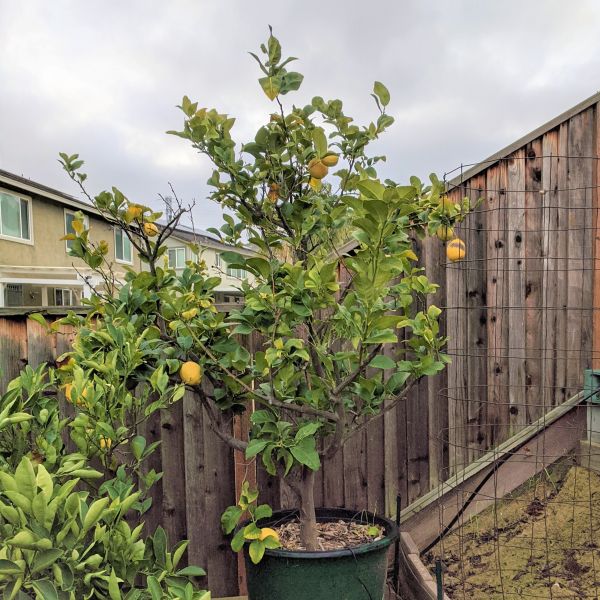Eureka Lemon Tree
Citrus limon 'Eureka'
Plant Sentry™
Plant Sentry™

Plant Sentry™ Protected
Your order is protected by our compliance system that:
- Prevents restricted plants from shipping to your state
- Ensures plants meet your state's agricultural requirements
- Protects gardens from invasive pests and diseases
Delivery and Shipping
Delivery and Shipping
Delivery and Shipping
Fast, Safe Plant Delivery
Ships in 3-4 business days • Tracking provided • Weather protected
| Under $50 | $9.99 |
| $50 - $99.99 | $14.99 |
| $100 - $149.99 | $16.99 |
| $150 - $198.99 | $24.99 |
| $199+ | FREE |
✓ Zone-specific timing • ✓ Professional packaging • ✓ Health guarantee
Understanding Plant Options
Nature Hills offers plants in two main formats:
- Container Plants: Grown in pots with soil, sized by container volume and plant age
- Bare Root Plants: Dormant plants without soil, sized by height measurements
Container Plant Sizes
Container sizes indicate plant age and growing capacity rather than liquid volume equivalents. Our containers follow industry-standard nursery "trade gallon" specifications, which differ from standard liquid gallon measurements.
Young Plants (6 months to 18 months old)
| Container Size | Actual Volume | Metric Equivalent |
|---|---|---|
| 2" x 2" x 3" | 0.18 - 0.21 dry quarts | 0.20 - 0.23 dry liters |
| 4" Container | 0.31 - 0.87 dry quarts | 0.35 - 0.96 dry liters |
| 4.5" Container | 0.65 dry quarts | 0.72 dry liters |
| 6" Container | 1.4 dry quarts | 1.59 dry liters |
| 1 Quart | 1 dry quart | 1.1 dry liters |
| 5.5" Container | 1.89 dry quarts | 2.08 dry liters |
Established Plants (18 months to 2.5 years old)
| Container Size | Actual Volume | Metric Equivalent |
|---|---|---|
| 2 Quart | 2 dry quarts | 2.2 dry liters |
| #1 Container | 2.26 - 3.73 dry quarts | 2.49 - 4.11 dry liters |
| 5" x 5" x 12" | 3.5 - 4.3 dry quarts | 3.85 - 4.74 dry liters |
Mature Plants (2-4 years old)
| Container Size | Actual Volume | Metric Equivalent |
|---|---|---|
| #2 Container | 1.19 - 1.76 dry gallons | 5.24 - 7.75 dry liters |
| #3 Container | 2.15 - 2.76 dry gallons | 8.14 - 12.16 dry liters |
Large Plants (3-5 years old)
| Container Size | Actual Volume | Metric Equivalent |
|---|---|---|
| #5 Container | 2.92 - 4.62 dry gallons | 12.86 - 20.35 dry liters |
| #6 Container | 5.25 - 6.01 dry gallons | 23.12 - 26.42 dry liters |
| #7 Container | 5.98 - 6.53 dry gallons | 26.34 - 28.76 dry liters |
Bare Root Plants
Bare root plants are sold by height from the root system to the top of the plant. Plants may exceed minimum height requirements.
Common Sizes:
- Trees: 1 foot, 2 feet, 3 feet, 4 feet, 5 feet, 6 feet
- Shrubs & Perennials: 1 foot, 18 inches, 2 feet
Important Notes
Container Volume Specifications
- Trade Gallon Standard: Our containers follow industry-standard "trade gallon" specifications established by the American National Standards Institute (ANSI Z60.1) for nursery stock
- Volume Variations: Actual soil volume may vary due to plant root systems and growing medium settlement
- Age Indicators: Container size primarily indicates plant age and maturity rather than liquid volume equivalents
Growing Conditions
- Plant size can vary based on variety and growing conditions
- Container size helps indicate plant maturity and establishment level
- Larger containers generally mean more established root systems and faster landscape establishment
Seasonal Availability
- Bare root plants are available seasonally when dormant
- Container plants are available throughout the growing season
- Specific varieties may have limited availability in certain sizes
Questions?
For questions about specific plant sizes or availability, please contact our plant experts who can help you choose the right size for your landscape needs.

Plant Sentry™ Protected
Your order is protected by our compliance system that:
- Prevents restricted plants from shipping to your state
- Ensures plants meet your state's agricultural requirements
- Protects gardens from invasive pests and diseases
Plant Profile & Growing Essentials
Evergreen, Flowering, Fragrant, Edible, Self-pollinating, Ornamental Berries/Fruit, Heat Tolerant, and Container Friendly
Specifications
Specifications
-
Botanical Name
-
Height
-
Width
-
Growing Zones
-
Sunlight
-
Growth RateModerate
-
Flower Color
-
Leaf Color
-
Fall Color
-
Pollinator FriendlyYes
-
Pollinator Required
-
Bloom PeriodLate Spring, Early Summer, Late Summer, Early Fall, Late Fall
Planting & Care Instructions
Planting & Care Instructions

Growing Zones 8-10 (patio 4-10)
The Eureka Lemon Tree is a big producer in hot climates! For growers in Zones 8 - 10, the Eureka Lemon Tree (Citrus limon 'Eureka') is a beautifully productive true Lemon Tree. It will bear fruit in large crops of Lemons all year long, but you'll notice that the harvest ramps up in spring and summer!
You've seen this standard pale yellow variety at the grocery store, but it's so easy to grow your own - why not give it a try? Eurekas have a true lemon flavor with very few to no seeds. The thick-skinned fruit is known primarily for its juice.
Pink fleshed Eureka lemons have delicious, acidic tart juice. You'll love having large, juicy lemons on hand for cooking and juicing. They'll add a tremendous amount of flavor to just about any dish or drink - sweet or savory.
You know that Lemons are rich in Vitamin C, but did you know they also provide potassium and folic acid? Great for detox diets, just squeeze your own Lemon into a glass of water as a morning 'pick me up'.
Keep your harvest in a plastic bag in the refrigerator for up to 2 weeks, or use Lemons stored at room temperature within 1 week. You can also freeze the juice and the zested peel. Try preserving Lemons in olive oil and stored in the fridge. There is nothing better to use on chicken!
The Eureka Lemon has fewer thorns than other traditional lemons and the ones they have are much smaller than other Lemon varieties as well. Pruning and picking are a breeze.
If you live in Zones 8 - 10, Eureka Lemon Trees will grow in your garden as a beautiful, fragrant and useful shade tree. You can easily keep them 'right-sized' with simple pruning.
You'll adore this incredible, high-yield variety. Grow Eureka Lemons at home - order today!
Is Eureka Lemon Tree Right for You?
Eureka needs lots of very bright light to thrive, so if you live in Zones 4 - 8, please choose an Improved Dwarf Meyer Lemon tree for indoor/outdoor growing. If you have a greenhouse or south-facing window, you can grow Eureka Lemon trees inside. Just be sure it gets a lot of light!
The Eureka Lemon prefers hotter climates and is not well adapted to the coast. For a coastal traditional style Lemon, choose a Lisbon Lemon, which does well in milder climates and produces fine, small lemons.
Tips for Growing Eureka Lemons
You can keep a Eureka Lemon tree pruned for size, as it tolerates pruning and espalier for planting in the ground. In areas where it won't drop below 20°F during the winter, you can easily grow it in large containers.
Use the Eureka Lemon as a Patio Tree in a wonderful statement container with large holes for drainage. Place it behind a set of chairs or sling a hammock in its shade. You'll love the sunny yellow lemon 'decorations' that develop on your privacy screen.
You can prune it into a single-trunk tree, front or backyard specimen, or prominent edible landscaping focal point by removing the lower side branches all the way back to the main trunk. Or, create a shrubby look by letting those lower lateral branches grow out down the main trunk. Just remove any crossing branches that rub together.
When container planting, use a fast-draining, acidic potting soil mixed with 1/4 extra pumice or pathway bark. You want to ensure good drainage and nutrient holding over the years that the plant will be in the container.
With a naturally spreading growth habit, Eureka Lemon trees are absolutely beautiful when espaliered or pruned flat against a sturdy trellis. With its evergreen foliage, it is the perfect plant to insulate the house from the hot afternoon sun. Lemons love the heat and are easy to maintain as a flat plant trained to grow along a trellis. Pruning techniques like this really make for an easy harvest.
- Wonderful True Lemon
- High Yields All Year Long
- Heaviest Fruit Production in Spring and Summer Growing Seasons
- Plant in Ground, Espalier or Use in Containers Outdoors
- Spreading, Attractive, Fragrant Tree for Specimen or Screen
- Fewer Thorns than other Varieties
#ProPlantTips for Care
Citrus requires good drainage and full sun to grow well. They prefer to be kept on the dry side, although watering can vary with location and soil characteristics. Allow your Lemon Tree to become somewhat dry between waterings. When you do water, drench them but make sure the water drains away rapidly.
You'll also want to keep containers on the dry side. Watering needs will depend on your container size, its drainage, and the location of the tree. Citrus prefers to dry out slightly between waterings, but if you have a soggy area, create and plant in a raised berm.
For the easiest picking, be sure to prune your tree regularly. The goal is to keep your Eureka Lemon tree below 10 feet.
If you want to use this as a privacy tree, simply let the tree grow naturally into its full mature size. The dense canopy will block unwanted views beautifully.
Citrus is an acid-loving plant and prefers acid soils with a pH of 6 to 6.5. Fertilize with Dr. Earth Acid Lovers Organic and Natural Premium Fertilizer. For best results, apply twice a year in the ground, once in the spring and once again in the late winter. A well-fed Citrus tree is better prepared to tolerate cold temperatures through the fall and winter months. For containers, apply fertilizer every 3 months.
- Full Sun For The Best Fruit
- Must Have Well-Drained Slightly Acidic Soil
- Moderate to Low Moisture Needs
- Prune In Spring
- Heat & Humidity Tolerant
Hurry, Quantities Are Limited!
Our trees have extensive branching and some of the largest root systems available. We take pride in delivering you the highest quality Citrus Trees with healthy roots and full, well-established stems and foliage.
Our trees are always in high demand, and this variety is very popular. Order now at Nature Hills Nursery before they sell out and enjoy the benefits of growing your own Eureka Lemon Tree.
Protecting Container Citrus From Cold
If you're growing these tropical trees in the ground in the lowest of their favored growing zones, they need to be planted in a sheltered spot to avoid the worst of the chill. If a spot like that is unavailable then you are better off planting in a large, deep container.
This Citrus variety naturally grows successfully in marginal Citrus areas (USDA zones 8 to 4). But Citrus trees grown in these zones should be grown in containers and brought indoors before the wintertime.
In cooler growing zones, begin slowly acclimating your tree indoors in the early fall or moving them into a protected location, eventually moving your tree inside in bright indirect sun for the winter if the temperatures in your area ever dip below that 40°F range.
In spring, reverse this process and begin acclimating your tree to again be back out in the full sun all summer. This reduces stress and leaf drop.
Very Popular Eureka Lemon
When one thinks of a true lemon, the Eureka Lemon is typically the fruit they are thinking of. However, it's actually one of many Italian-style lemons that all are similar in fruit type but differ in their habit and adaptability.
Originating from seeds sent from Lunario, Italy to Los Angeles, California, and said to have been planted in 1858. Selections were made from the resulting seedlings by Andrew Boyle and C. R. Workman. Somewhere around 1877, Thomas A. Garey, a Los Angeles nurseryman, was given budwood by Woodman from what was determined to be a more promising selection. Garey then propagated and introduced the variety as Garey's Eureka Lemon.
It produced an abundant crop at a young age, had far fewer thorns and what seemed to be an everbearing habit. These features quickly propelled the Eureka to be as one of the most popular with growers. It was not long until the Eureka was being grown in all the major citrus regions around the world.
With all the Eureka's qualities, it is less vigorous and cold-hardy than other Italian Lemon selections. This somewhat limits its overall range. It is not particularly adapted to high humidity but tolerates warm, dry conditions making it particularly suited to most citrus growing regions. Fruit is set on the outer reaches of the branch, so harvesting is easy.














